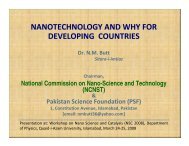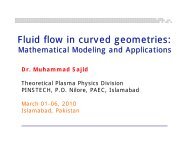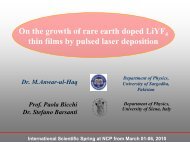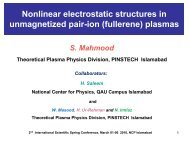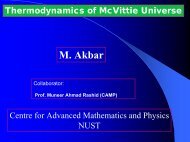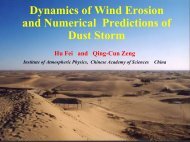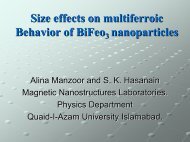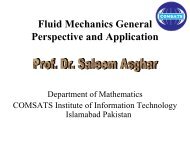LHC: Physics, Status & Prospects - National Centre for Physics
LHC: Physics, Status & Prospects - National Centre for Physics
LHC: Physics, Status & Prospects - National Centre for Physics
Create successful ePaper yourself
Turn your PDF publications into a flip-book with our unique Google optimized e-Paper software.
<strong>National</strong> <strong>Centre</strong> <strong>for</strong> <strong>Physics</strong>, Qaid-I-Azam University<br />
October 20 th , 2003<br />
<strong>LHC</strong>: <strong>Physics</strong>, <strong>Status</strong> &<br />
<strong>Prospects</strong><br />
John Ellis,<br />
CERN, Geneva, Switzerland
The Large Hadron Collider (<strong>LHC</strong>)<br />
Proton- Proton Collider<br />
7 TeV + 7 TeV<br />
Luminosity = 10 34 cm -2 sec -1<br />
Primary targets:<br />
•Origin of mass<br />
•Nature of Dark Matter<br />
•Primordial Plasma<br />
•Matter vs Antimatter
The First Direct Exploration of<br />
the TeV Scale …<br />
• Why is this interesting<br />
Any new energy range takes us deeper inside<br />
matter, but also …<br />
• Several reasons to expect new physics:<br />
Origin of particle masses<br />
Stabilization of gauge hierarchy<br />
Unification of couplings<br />
Dark matter<br />
g – 2 of muon
Production of Inner Cable <strong>for</strong> Magnets<br />
See more on the CERN website
Magnet Cold Masses Stored at CERN
Cryoline Installation<br />
Started at Point 8<br />
July 21, 2003
<strong>LHC</strong> hardware from CERN<br />
Non-Member States<br />
Russia:<br />
Also USA,<br />
Japan,<br />
Canada,<br />
India<br />
Warm dipoles from<br />
the Budker Institute<br />
(Novosibirsk)<br />
stored at CERN
Overall View of the Large Hadron Collider (<strong>LHC</strong>)<br />
NCP, Pakistan
Site of CMS Construction
CMS, Point 5<br />
Shafts leading down to<br />
CMS pit<br />
Main cavern shaft<br />
Service cavern shaft
CMS Experiment<br />
SUPERCONDUCTING<br />
COIL<br />
CALORIMETERS<br />
ECAL<br />
Scintillating<br />
PbWO4 crystals<br />
HCAL<br />
Plastic scintillator/<br />
brass sandwich<br />
IRON YOKE<br />
TRACKER<br />
Silicon<br />
Micro-strip<br />
Pixels<br />
Total weight : 12,500 t<br />
Overall diameter : 15 m<br />
Overall length : 21.6 m<br />
Magnetic field : 4 Tesla<br />
Drift Tube<br />
Chambers<br />
MUON BARREL<br />
Resistive Plate<br />
Chambers<br />
MUON<br />
ENDCAPS<br />
Cathode Strip Chambers<br />
Resistive Plate Chambers
CMS: Superconducting Coil<br />
Insertion Test
CMS: Hadronic Calorimeters<br />
One end-cap complete,<br />
other in Dec. 03<br />
Barrel complete, install<br />
electronics by June 04
ALICE: Detector <strong>for</strong> Heavy-Ion Collisions
The <strong>Physics</strong> Scope of the <strong>LHC</strong><br />
Interesting cross sections<br />
Bread-and-butter physics<br />
W<br />
∆m = 15 MeV<br />
Susy<br />
top<br />
Higgs<br />
∆m = 1 GeV
The Role of the Higgs Boson<br />
• Massless gauge bosons, e.g. the photon<br />
has 2 polarization states: +1, -1<br />
• Massive gauge bosons, e.g., W, Z<br />
• Need additional polarization state<br />
with zero spin projection<br />
• Provided by scalar field<br />
as postulated by Higgs, Brout and Englert<br />
• Minimal Standard Model has extra particle<br />
as pointed out by Higgs: the Higgs boson
Searches <strong>for</strong> the Higgs Boson<br />
Indirect:<br />
• Precision electroweak<br />
measurements at LEP,<br />
SLC, etc<br />
• Predicted successfully<br />
m t = 160 – 180 GeV<br />
• Sensitive to mass<br />
of Higgs boson<br />
m H < 200 GeV <br />
• Direct:<br />
• LEP Searches <strong>for</strong><br />
e + e - -> Z + H<br />
• Hint seen in late 2000<br />
now < 2 σ<br />
Current Limit:<br />
m H > 114.4 GeV
A Higgs Event in CMS
Some Sample Higgs Signals<br />
γγ<br />
ZZ* -> llll<br />
ttH<br />
bbH
Higgs Detection at the <strong>LHC</strong><br />
The Higgs may be found quite quickly …<br />
… in several different channels<br />
m H > 114.4 GeV<br />
here discovery easier<br />
with H → 4 leptons
Why Supersymmetry<br />
• Hierarchy problem: why is m W > G N = 1/m P2 <br />
• Or, why is<br />
V Coulomb >> V Newton e 2 >> G m 2 = m 2 / m P<br />
2<br />
• Set by hand What about loop corrections<br />
δm H,W2 = O(α/π) Λ 2<br />
• Cancel boson loops fermions<br />
• Need | m B2 –m F2 | < 1 TeV 2
Other Reasons to like Susy<br />
It enables the gauge couplings to unify<br />
It stabilizes the Higgs potential <strong>for</strong> low masses
Dark Matter in the Universe<br />
Astronomers say<br />
that most of the<br />
Astronomers tell<br />
matter us that most in theof the<br />
Universe matter in the is<br />
universe is<br />
invisible<br />
invisible<br />
Dark Matter<br />
`Supersymmetric’ particles <br />
We will look <strong>for</strong> it<br />
We shall look <strong>for</strong><br />
them with the with <strong>LHC</strong> the<br />
<strong>LHC</strong>
Constraints on Supersymmetry<br />
• Absence of sparticles at LEP, Tevatron<br />
selectron, chargino > 100 GeV<br />
squarks, gluino > 250 GeV<br />
• Indirect constraints<br />
Higgs > 114 GeV, b -> s γ<br />
• Density of dark matter<br />
g µ -2<br />
lightest sparticle χ:<br />
WMAP: 0.094 < Ω χ h 2 < 0.124
Supersymmetry Searches at <strong>LHC</strong><br />
`Typical’ supersymmetric<br />
Event at the <strong>LHC</strong><br />
<strong>LHC</strong> reach in<br />
supersymmetric<br />
parameter space
Supersymmetric Benchmark Studies<br />
Lines in<br />
susy space<br />
allowed by<br />
accelerators,<br />
WMAP data<br />
Specific<br />
benchmark<br />
Points along<br />
WMAP lines<br />
Sparticle<br />
detectability<br />
Along one<br />
WMAP line<br />
BDEG(M)OP(W)<br />
Calculation<br />
of relic<br />
density at a<br />
benchmark<br />
point
And if there are large extra dimensions & gravity becomes strong at the TeV scale<br />
Black Hole Production at <strong>LHC</strong><br />
Multiple jets,<br />
Leptons from<br />
Hawking<br />
Radiation
The Reach of the <strong>LHC</strong> <strong>for</strong> New<br />
High-Mass <strong>Physics</strong>
Hot and Dense Hadronic Matter<br />
Recreate the first 10 -6 seconds …<br />
<strong>LHC</strong><br />
… and probe the quark-hadron<br />
phase transition<br />
<strong>LHC</strong>
Recreating Big Bang with Little Bangs<br />
Jets<br />
Open charm, beauty<br />
Probe possible quark-gluon plasma using hadrons, photons, leptons, Z’s and jets
`Typical’<br />
Heavy-Ion<br />
Collision in<br />
ALICE<br />
8000 particles<br />
In the central<br />
detector
Computing Grid &<br />
Network Projects<br />
CrossGrid<br />
US Projects<br />
European Projects
LCG<br />
LCG1 - Grid Deployment<br />
• Certification and distribution process established<br />
• Middleware package – components from –<br />
– European DataGrid (EDG)<br />
– US (Globus, Condor, PPDG, GriPhyN) the Virtual Data Toolkit<br />
• Agreement reached on principles <strong>for</strong> registration and security<br />
• RAL (Ox<strong>for</strong>d, UK) to provide the initial grid operations centre<br />
• FZK (Karlsruhe, Germany) to operate the call centre<br />
• Initial service being deployed<br />
now to 10 centres<br />
US, Europe, Asia<br />
• Expand to other centres as<br />
soon as the service is stable<br />
Academia Sinica Taipei, BNL, CERN, CNAF, FNAL,<br />
FZK, IN2P3 Lyon, Moscow State Univ., RAL, Univ. Tokyo
The <strong>LHC</strong> will Probe<br />
New Dimensions of <strong>Physics</strong><br />
• A new dimension in energy: ~ TeV<br />
Origin of mass <br />
• New dimensions of space <br />
More `familiar’ bosonic dimensions <br />
Fermionic `quantum’ dimensions <br />
• New dimension of time<br />
~ 10 -12 sec after Big Bang<br />
Primordial soup <br />
Dark matter <br />
Origin of matter <br />
… and new dimensions in international collaboration
Not <strong>for</strong>getting technicolour …<br />
A techni-ρ resonance <br />
… or Compositeness<br />
Detectable if Λ < 50 TeV
Hard Probes of Quark-Gluon Plasma<br />
Look <strong>for</strong> quarkonium suppression …<br />
… compare with open charm production<br />
Suppressed by<br />
Debye screening<br />
in plasma
Z Production in Heavy-Ion Collisions<br />
Look <strong>for</strong> Z production at large p T<br />
…<br />
… and absence of jet<br />
on opposite side …<br />
… due to parton absorption in<br />
quark-gluon plasma
Probing CP Violation at the <strong>LHC</strong><br />
Within the Standard Model …<br />
… and beyond it <br />
B d →J/ψK S<br />
B d<br />
→D * π<br />
B s mixing<br />
γ not well known<br />
η<br />
|V ub /λV cs |<br />
φ ΝΡ<br />
ρ<br />
Possible signature of new physics
Sample <strong>LHC</strong>b<br />
Sensitivities<br />
2002 / be<strong>for</strong>e / after <strong>LHC</strong>b<br />
B d<br />
→J/ψK S<br />
B d →ππ<br />
B -> ππ<br />
Using<br />
Cerenkov<br />
Increase in<br />
statistics<br />
B s<br />
→J/ψφ<br />
B s →D s<br />
K<br />
Measuring γ
The Electroweak Vacuum<br />
• Generating particle masses requires<br />
breaking gauge symmetry:<br />
m W,Z =/= 0 =/= 0<br />
m<br />
2<br />
W = m Z2 cos 2 θ W => I = ½<br />
• I = ½ also needed <strong>for</strong> fermion masses<br />
• What is X Elementary or Composite
The Electroweak Vacuum<br />
• Generating particle masses requires<br />
breaking gauge symmetry:<br />
m W,Z =/= 0 =/= 0<br />
m<br />
2<br />
W = m Z2 cos 2 θ W => I = ½<br />
• I = ½ also needed <strong>for</strong> fermion masses<br />
• What is X Elementary or Composite
A la recherche du<br />
Higgs perdu …<br />
Higgs Production at the<br />
<strong>LHC</strong><br />
… not far away<br />
Combining direct,<br />
Indirect in<strong>for</strong>mation
Summary of <strong>LHC</strong><br />
Scapabilities<br />
… and Other<br />
Accelerators<br />
<strong>LHC</strong> almost<br />
`guaranteed’<br />
to discover<br />
supersymmetry<br />
if it is relevant<br />
to the mass problem<br />
BDEG(M)OP(W)



